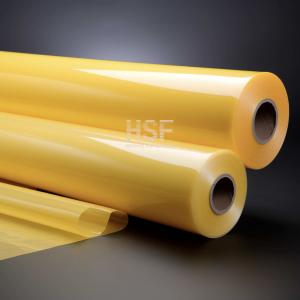

Add to Cart
40μm yellow cast polypropylene film for food, medical can industrial packaging
40-micron translucent yellow or opaque yellow cast polypropylene (CPP) film is a thin and flexible packaging material that is primarily
used in packaging applications where convenience and visual appeal are essential.
Here are some of the primary uses of 40-micron translucent yellow or opaque yellow CPP film:
1. Food Packaging:
40-micron CPP film is suitable for food packaging applications where product visibility is necessary, such as packaging for snacks, cereals,
and baked goods. The translucent yellow or opaque yellow color of the film also adds to the visual appeal of the packaging, making it more
attractive to customers.
2. Stationery Packaging:
The thin and flexible nature of 40-micron CPP film makes it an ideal choice for packaging stationery items like pens, pencils, and markers.
Its high clarity and flexibility enable the items to be visible through the packaging, making them more accessible and easier to identify.
3. Personal Care Packaging:
The film's high moisture barrier properties make it an ideal choice for packaging personal care products like soap, shampoo, and lotion.
4. Gift Wrapping:
The translucent yellow or opaque yellow color of 40-micron CPP film makes it a popular choice for gift wrapping, particularly for children.
Its high flexibility enables the film to be easily molded around the gift, and its colorful appearance adds to the visual appeal.
5. Office Supplies:
40-micron CPP film is suitable for packaging office supplies like notepads, adhesive tapes, and paper clips. Its high flexibility ensures
that the packaging remains intact during transportation and storage, while its clarity and thinness make it easier to identify the contents.
Overall, 40-micron translucent yellow or opaque yellow cast polypropylene film is a flexible and versatile packaging material primarily used in
applications where product visibility, convenience, and visual appeal are essential.
The significant feature of cast polypropylene film is its excellent
transparency, high gloss, and good moisture barriers making it
suitable for
packaging applications where product visibility is important. It is
also highly durable, flexible, and has excellent sealing
properties, making it
ideal for applications requiring heat sealing.Furthermore, CPP film
is highly resistant to punctures, tearing, and abrasion, which
makes it a
reliable option for packaging applications that face rough handling
during transportation.
Additionally, CPP film has good stiffness and dimensional
stability, which means it is unlikely to shrink or stretch during
processing or use,
which can help to ensure consistent packaging performance. It has
also good printability and great clarity of graphics, which makes
it ideal
for using visual cues as branding elements on packaging.
The process for producing cast polypropylene (CPP) film involves:
1. Polymerization:
Propylene monomers are polymerized under pressure and high
temperature to produce polypropylene resin pellets.
2. Extrusion:
The polypropylene resin pellets are melted and extruded through a
flat die to form a thin, continuous sheet.
3. Orientation:
The extruded sheet is stretched across the machine direction (MD)
and transverse direction (TD) to improve the mechanical
properties and clarity of the film.
4. Cooling:
The film is cooled down using a cooling roll and stored on a
take-up roll.
5. Finishing:
The film is treated with corona discharge or other surface
treatments to improve printing quality and adhesion.
Now, coming to the advantages of CPP film over Biaxially Oriented
Polypropylene (BOPP) film:
1. Improved sealing properties:
CPP film has better sealing properties due to its higher seal
strength, which makes it ideal for use in food packaging
applications.
2. Enhanced clarity:
CPP film has better clarity and gloss than BOPP film, which makes
it more attractive for use in packaging applications where product
visibility is essential.
3. Better hot tack properties:
CPP film has better hot tack properties, which allows it to be used
in high-speed packaging machines where quick sealing is required.
4. Increased heat resistance:
CPP films have greater heat resistance than BOPP films, making them
better suited for use in hot-fill and retort packaging applications
where high temperatures are required.
5. Higher puncture resistance:
CPP films have higher puncture resistance than BOPP films, making
them more durable and resistant to damage during transportation
and storage.
Overall, CPP film has several advantages over BOPP film, making it
a popular choice for a wide range of packaging applications. CPP
films' improved sealing properties, clarity, heat resistance, and
puncture resistance make them ideal for use in food packaging, as
well as in industrial and agricultural packaging applications.
| Test Item | Unit | Range | Test Standard | |
| Thickness | Avg. | μm | 40 | GN/T 6672 |
| Max. | ≤44 | |||
| Min. | ≥36 | |||
| Width | Avg. | mm | 1090 ±3 | GN/T 6673 |
| Tensile strength | MD | MPa | ≥20 | GN/T 1040.3 |
| TD | ≤15 | |||
| Elongation @ break | MD | % | ≤300 | GN/T 1040.3 |
| TD | ≤300 | |||
| Wetting tension | - | mM/m | ≥38 | GN/T 14216 |
